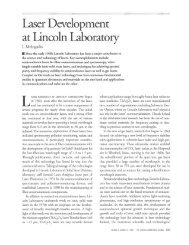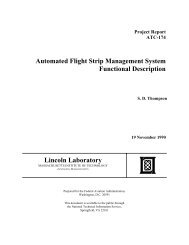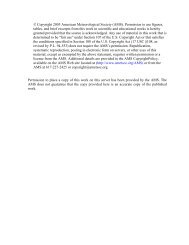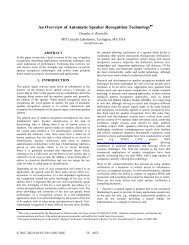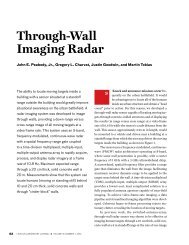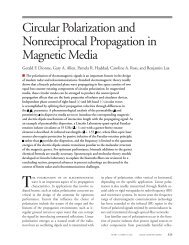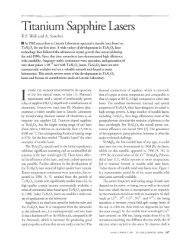The Route Availability Planning Tool (RAPT) - MIT Lincoln Laboratory
The Route Availability Planning Tool (RAPT) - MIT Lincoln Laboratory
The Route Availability Planning Tool (RAPT) - MIT Lincoln Laboratory
You also want an ePaper? Increase the reach of your titles
YUMPU automatically turns print PDFs into web optimized ePapers that Google loves.
impacts and available for use. To our knowledge, it is the only<br />
tool of its kind currently in operational use.<br />
In the summer of 2007, a comprehensive field evaluation<br />
of <strong>RAPT</strong> performance found that <strong>RAPT</strong> guidance provided a<br />
generally accurate assessment of route availability [6], and<br />
that significant delay reduction benefits could be achieved as a<br />
result of <strong>RAPT</strong> usage [4]. <strong>The</strong>se studies also found that oversensitivity<br />
to small-scale features of the input weather<br />
forecasts occasionally resulted in poor or unstable <strong>RAPT</strong><br />
guidance, which, in turn, reduced user confidence and<br />
realization of potential benefits. In order to improve the<br />
robustness of <strong>RAPT</strong> guidance, the <strong>RAPT</strong> route blockage<br />
algorithm was significantly redesigned, and a new version was<br />
deployed operationally in July, 2008.<br />
A second field study was performed in 2008 to evaluate the<br />
<strong>RAPT</strong> concept of operations, the quality of <strong>RAPT</strong> guidance,<br />
and the observed and potential delay reductions achievable as<br />
a result of <strong>RAPT</strong> usage. This paper presents an analysis of the<br />
accuracy of <strong>RAPT</strong> guidance and its ability to support the<br />
operational concept. <strong>RAPT</strong>, its operational concept and route<br />
blockage algorithm are described. <strong>The</strong> accuracy and<br />
operational relevance of <strong>RAPT</strong> guidance is evaluated, based<br />
on an analysis of several case days from the summer of 2008.<br />
Finally, enhancements planned for deployment in 2009 are<br />
presented. A second paper [1], also based on the field<br />
evaluation, presents an analysis of observed benefits, missed<br />
a.<br />
700 km.<br />
500 km.<br />
O climb<br />
O transition<br />
O near en route<br />
O en route<br />
opportunities and the operational decision making<br />
environment in which <strong>RAPT</strong> is deployed.<br />
II. <strong>RAPT</strong> DESCRIPTION<br />
<strong>RAPT</strong> is intended to reduce departure delays by<br />
automatically identifying opportunities for efficient, proactive<br />
and consistent use of available departure routes. <strong>RAPT</strong><br />
calculates route blockage along departure routes that are<br />
defined by four-dimensional, modeled flight trajectories that<br />
extend out to 60 minutes flight time. Trajectory points are<br />
calculated at one minute intervals.<br />
Flight trajectories have four phases – climb, transition, near<br />
en route and en route – that reflect flight altitude and airspace<br />
complexity. <strong>Route</strong>s are defined by ‘blockage boxes’ centered<br />
on the trajectory points, and box length and width are<br />
functions of the flight phase. <strong>The</strong> lengths are set to<br />
approximately two minutes flight distance, and the widths<br />
reflect the route density and the ability of air traffic control to<br />
maneuver flights around convective weather in the region<br />
traversed during the flight phase. Typically, routes are wide<br />
during the climb and transition phases (inside the TRACON),<br />
become narrower in the near en route phase where departure<br />
and arrival routes are densely packed (ZNY and northern<br />
ZDC), and widen again in the en route phase where routes are<br />
not so densely packed (ZOB and southern ZDC). Figure 1<br />
illustrates <strong>RAPT</strong> departure routes.<br />
b. route bounds<br />
en route<br />
near en route<br />
Figure 1. <strong>RAPT</strong> departure routes (a) and inset showing different route widths in near en route and en route airspace.<br />
Figure 2 illustrates the <strong>RAPT</strong> algorithm. Vertically<br />
integrated liquid (VIL) and echo tops forecasts from the<br />
Corridor Integrated Weather System (CIWS) [7] are input to a<br />
Weather Avoidance Field (WAF) generator that estimates the<br />
probability of pilot deviation at each pixel in the <strong>RAPT</strong><br />
domain. VIL provides a measure of precipitation intensity and<br />
the echo tops give an estimate of storm height, both of which<br />
are important factors in determining the severity of convective<br />
weather. <strong>The</strong> WAF in the TRACON is based on a heuristic<br />
convective weather avoidance model (CWAM), in which VIL<br />
intensity is the dominant factor. In en route airspace, the WAF<br />
is based on an en route CWAM [8], in which echo top height<br />
is dominant. Transition between TRACON and en route WAF<br />
occurs over a 20 km range (between 80 and 100 km from<br />
Newark International airport), in which WAF deviation<br />
probabilities are a range-weighted average between TRACON<br />
and en route WAF. WAF predictions are generated at five<br />
minute intervals, in synchronization with the CIWS forecast<br />
updates.<br />
<strong>The</strong> route blockage algorithm [9][10] calculates a route<br />
blockage at each trajectory point as a function of the WAF



